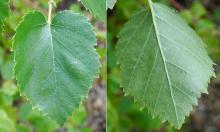Betula occidentalis
Common name:
Water Birch
Western Birch
Red Birch
River Birch
Black Birch
Pronunciation:
BET-u-la ok-si-den-TA-lis
Family:
Betulaceae
Genus:
Synonyms:
Betula fontinalis
Type:
Broadleaf
Native to (or naturalized in) Oregon:
Yes
- Broadleaf deciduous shrub/tree, highly variable, frequently in clumps, often 15-30 ft (4.5-9 m) tall, rarely to 40 ft (12 m), upright when young, branches more nodding with age. Twigs thin, often pubescent, reddish-brown, with many warty resin glands. Bark thin, glossy, black-brown to purplish-brown, not peeling, long horizontal lenticels. Leaves alternate, simple, small, 2-5 cm long, apex wedge-shaped, blunt or sharp, base cordate or rounded, margin sharply and doubly serrate (two sizes), 4-5 veins per side, each ending in a tooth, shiny yellow-green above, paler with very small dots (glands) below; fall color is clear yellow. Male catkins at pollination about 6 cm long, female catkins 2-3 cm long, mature seed catkins 2.5-4 cm long, slender, pendulous.
- Sun. Best in moist, well-drained soil.
- Hardy to USDA Zone 2-4 Native to mostly western North America from southern Alaska to southern Manitoba and North Dakota, south and west to southern California and New Mexico. In Washington and Oregon it is most commonly found on the east side of the Cascades. It is absent from the Pacific Coastal mountain ranges. A riparian plant, and nearly always found along streams, springs, or other water courses. In parts of Oregon, Washington, Idaho, and British Columbia it freely hybridizes with paper birch (P. papyrifera) producing many intermediate forms.
- occidentalis: of the western world.







